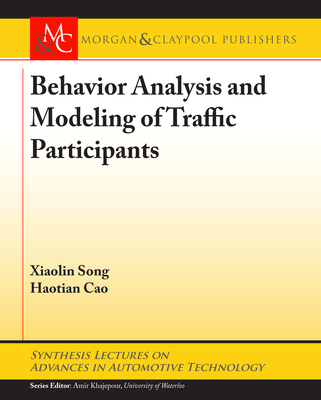Decision Making, Planning, and Control Strategies for Intelligent Vehicles
暫譯: 智能車輛的決策、規劃與控制策略
Cao, Haotian, Li, Mingjun, Zhao, Song
- 出版商: Morgan & Claypool
- 出版日期: 2020-07-28
- 售價: $1,920
- 貴賓價: 9.5 折 $1,824
- 語言: 英文
- 頁數: 138
- 裝訂: Quality Paper - also called trade paper
- ISBN: 1681738821
- ISBN-13: 9781681738826
海外代購書籍(需單獨結帳)
商品描述
The intelligent vehicle will play a crucial and essential role in the development of the future intelligent transportation system, which is developing toward the connected driving environment, ultimate driving safety, and comforts, as well as green efficiency. While the decision making, planning, and control are extremely vital components of the intelligent vehicle, these modules act as a bridge, connecting the subsystem of the environmental perception and the bottom-level control execution of the vehicle as well. This short book covers various strategies of designing the decision making, trajectory planning, and tracking control, as well as share driving, of the human-automation to adapt to different levels of the automated driving system.
More specifically, we introduce an end-to-end decision-making module based on the deep Q-learning, and improved path-planning methods based on artificial potentials and elastic bands which are designed for obstacle avoidance. Then, the optimal method based on the convex optimization and the natural cubic spline is presented.
As for the speed planning, planning methods based on the multi-object optimization and high-order polynomials, and a method with convex optimization and natural cubic splines, are proposed for the non-vehicle-following scenario (e.g., free driving, lane change, obstacle avoidance), while the planning method based on vehicle-following kinematics and the model predictive control (MPC) is adopted for the car-following scenario. We introduce two robust tracking methods for the trajectory following. The first one, based on nonlinear vehicle longitudinal or path-preview dynamic systems, utilizes the adaptive sliding mode control (SMC) law which can compensate for uncertainties to follow the speed or path profiles. The second one is based on the five-degrees-of-freedom nonlinear vehicle dynamical system that utilizes the linearized time-varying MPC to track the speed and path profile simultaneously.
Toward human-automation cooperative driving systems, we introduce two control strategies to address the control authority and conflict management problems between the human driver and the automated driving systems. Driving safety field and game theory are utilized to propose a game-based strategy, which is used to deal with path conflicts during obstacle avoidance. Driver's driving intention, situation assessment, and performance index are employed for the development of the fuzzy-based strategy.
Multiple case studies and demos are included in each chapter to show the effectiveness of the proposed approach. We sincerely hope the contents of this short book provide certain theoretical guidance and technical supports for the development of intelligent vehicle technology.
商品描述(中文翻譯)
智慧車輛在未來智慧交通系統的發展中將扮演關鍵且重要的角色,該系統正朝向連接駕駛環境、最終駕駛安全、舒適性以及綠色效率的方向發展。雖然決策、規劃和控制是智慧車輛中極為重要的組件,但這些模組同時也充當橋樑,連接環境感知的子系統與車輛的底層控制執行。本書簡要介紹了設計決策、軌跡規劃、跟蹤控制以及人機協作駕駛的各種策略,以適應不同層級的自動駕駛系統。
更具體地說,我們介紹了一個基於深度 Q 學習的端到端決策模組,以及基於人工勢能和彈性帶的改進路徑規劃方法,這些方法旨在實現障礙物迴避。接著,提出了一種基於凸優化和自然三次樣條的最佳方法。
至於速度規劃,針對非車輛跟隨場景(例如,自由駕駛、變換車道、障礙物迴避),提出了基於多目標優化和高階多項式的規劃方法,以及一種結合凸優化和自然三次樣條的方法,而針對車輛跟隨場景則採用了基於車輛跟隨運動學和模型預測控制(MPC)的規劃方法。我們介紹了兩種穩健的跟蹤方法以實現軌跡跟隨。第一種方法基於非線性車輛縱向或路徑預覽動態系統,利用自適應滑模控制(SMC)法則來補償不確定性,以跟隨速度或路徑輪廓。第二種方法基於五自由度非線性車輛動態系統,利用線性化的時間變化 MPC 同時跟蹤速度和路徑輪廓。
針對人機協作駕駛系統,我們介紹了兩種控制策略,以解決人類駕駛者與自動駕駛系統之間的控制權限和衝突管理問題。利用駕駛安全領域和博弈理論提出了一種基於博弈的策略,用於處理障礙物迴避過程中的路徑衝突。駕駛者的駕駛意圖、情境評估和性能指標被用於模糊基礎策略的發展。
每一章中都包含多個案例研究和示範,以展示所提出方法的有效性。我們真誠希望本書的內容能為智慧車輛技術的發展提供一定的理論指導和技術支持。










